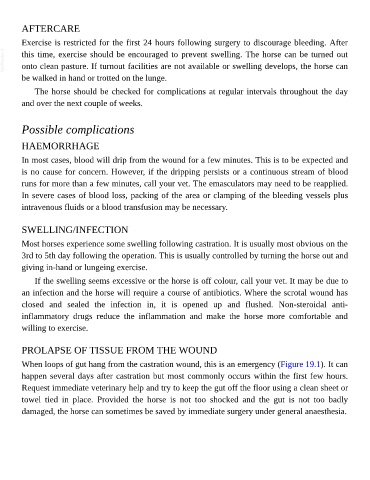Page 910 - The Veterinary Care of the Horse
P. 910
AFTERCARE
Exercise is restricted for the first 24 hours following surgery to discourage bleeding. After
VetBooks.ir this time, exercise should be encouraged to prevent swelling. The horse can be turned out
onto clean pasture. If turnout facilities are not available or swelling develops, the horse can
be walked in hand or trotted on the lunge.
The horse should be checked for complications at regular intervals throughout the day
and over the next couple of weeks.
Possible complications
HAEMORRHAGE
In most cases, blood will drip from the wound for a few minutes. This is to be expected and
is no cause for concern. However, if the dripping persists or a continuous stream of blood
runs for more than a few minutes, call your vet. The emasculators may need to be reapplied.
In severe cases of blood loss, packing of the area or clamping of the bleeding vessels plus
intravenous fluids or a blood transfusion may be necessary.
SWELLING/INFECTION
Most horses experience some swelling following castration. It is usually most obvious on the
3rd to 5th day following the operation. This is usually controlled by turning the horse out and
giving in-hand or lungeing exercise.
If the swelling seems excessive or the horse is off colour, call your vet. It may be due to
an infection and the horse will require a course of antibiotics. Where the scrotal wound has
closed and sealed the infection in, it is opened up and flushed. Non-steroidal anti-
inflammatory drugs reduce the inflammation and make the horse more comfortable and
willing to exercise.
PROLAPSE OF TISSUE FROM THE WOUND
When loops of gut hang from the castration wound, this is an emergency (Figure 19.1). It can
happen several days after castration but most commonly occurs within the first few hours.
Request immediate veterinary help and try to keep the gut off the floor using a clean sheet or
towel tied in place. Provided the horse is not too shocked and the gut is not too badly
damaged, the horse can sometimes be saved by immediate surgery under general anaesthesia.

